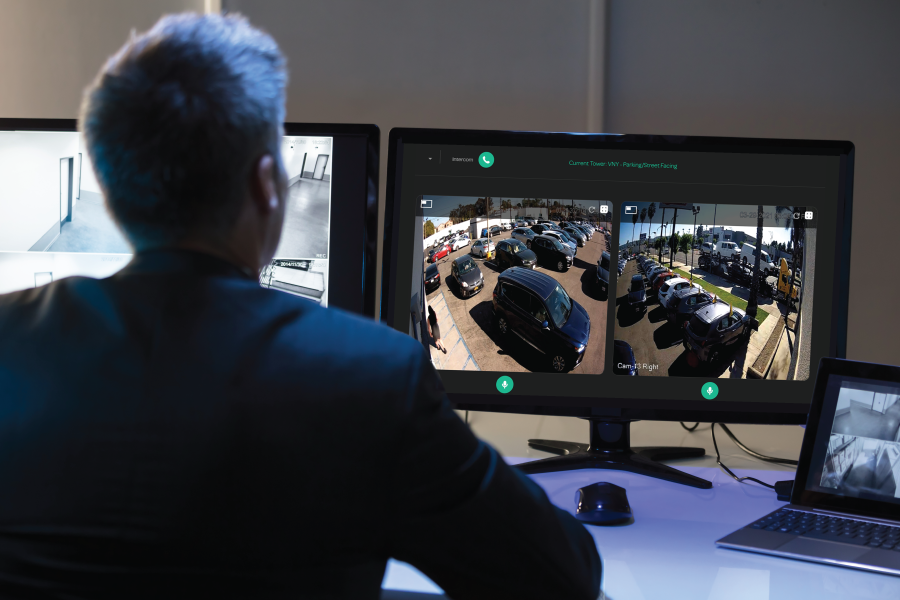We mean no disrespect to our colleagues in the security industry, but this question begs asking. Why are so many of you paying so much for security guard and monitoring services when, most of the time, the people you’re paying spend their time doing a whole lot of nothing?
Some would argue that “nothing” is the point. Merely by being present, onsite guards serve as an effective crime deterrent, increasing the likelihood that nothing (or very little) bad happens. As long as a guard is publicly visible, in uniform, criminals think twice before turning nefarious plans into actions. As for camera monitoring – whether it’s handled by the officer present who periodically glances at a bank of live feeds or by the guard company’s remote monitoring station, the out-of-pocket cost is steep for a service that rarely involves the effort of incident response. Security stakeholders justify the price by comparing it to the potential liability or loss due to a lack of coverage. Fair point, but that argument assumes that highly effective and desirable security alternatives do not exist for far less money.
In fact, they do! Robotic Assistance Devices (RAD) has partnered with innovative companies like Centralized Vision and EyeForce – bringing to market state-of-the-art remote monitoring that, when coupled with any of the RAD technology solutions, redefines the way comprehensive security services are delivered and priced. This model engages technically savvy security officers, well trained to identify threats, analyze risk, and execute responses, for a significantly lower total cost than traditional services. It does so by reserving the use of officers exclusively for tasks where they can deliver unique value, while leveraging RAD’s AI-assisted technology for the more mundane day-to-day responsibilities that consume the vast majority of traditional guard services’ billable hours.
RAD’s solutions deliver the deterrent effect of onsite guards along with 24/7 monitoring. Technology that can serve as a meaningful deterrent is something new and novel to the security market, but we’ll save the details of how we do that for another post. (Check out our Midway Auto Group Case Study for a slam-dunk proof of concept.) Here, we’ll focus primarily on the monitoring aspect of such a solution.
We refer to RAD’s offerings as “Autonomous Remote Services,” or ARS. The physical hardware of an ARS system, which serves as a conduit for delivering our software-driven services, comes in various shapes and sizes (7’ tower, wall unit, a roving vehicle, and more) and houses powerful HD cameras along with other security-related technology. Depending on the model, RAD devices include two-way audio, data, and video communication capabilities. Camera video, streamed via an enhanced cellular connection, is processed in RAD’s AI-driven cloud platform, which can identify the presence of people and vehicles and apply more sophisticated algorithms like facial and license plate recognition. With a very high level of accuracy, RAD’s software can differentiate, in real-time, between hum-drum, nothing-to-see here video and video featuring events that merit immediate analysis by security professionals.
That’s where RAD’s partnerships with Centralized Vision and EyeForce come in. RAD’s software pushes live video streams to their trained monitoring teams. Based on what they see, the remote officers are free to investigate further by viewing a live or recorded video stream, calling up other nearby cameras, and opening up a two-way communication channel with the surveillance site through the RAD unit. Bad actors are warned that they are being recorded and urged to leave, while individuals needing support receive personalized, remote assistance while onsite help is summoned. The monitoring officer may also share video of the event with law enforcement and other first-responders, as appropriate.
This proven, highly effective approach to monitoring costs a fraction of traditional guard services. Why? Because RAD technology limits the actual time security officers must attend to your organization’s needs. RAD’s AI-assisted software handles the “first cut” of monitoring services. You’ll have all the best human support you need when you need it, but these low service rates are based on the premise that RAD’s applications will lead the charge the vast majority of the time. The economies of scale are apparent. With far fewer guards monitoring far more cameras and the cost of their salaries spread across many more customers, everyone wins.
RAD also offers an appealing option for companies that need just a few cameras – including businesses that generally wouldn’t budget for traditional guard services. They can monitor the system themselves. RAD’s technology is so good a deterring vandalism, loitering, theft, and other criminal behaviors, and RAD’s AI is so effective at identifying people and vehicles, that the number of alerts that require viewing and a response is quite manageable – especially when a team of administrators and managers shares the responsibility. As an example, here’s a link to another case study, for Citrus Construction, a Florida firm that is using our solution at their building sites. As Citrus explains, as their system expands, they will eventually relinquish the monitoring role and hire RAD to take care of it, but for now, we fully support their DIY preference. It’s a great example of the scalability and flexibility of the ARS security model.
We get it. Security is one of your organization’s highest priorities. Tinkering with what’s working may seem like an unnecessary risk. As they say, “If it ain’t broke, don’t fix it.” But something is broken – the price! You can improve your company’s security posture while diverting a considerable chunk of security dollars to other profit-driving areas of your business. Isn’t that worth a conversation?

